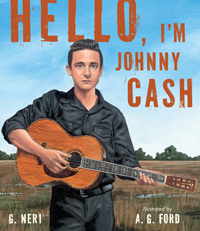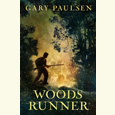Picturing the Man in Black
G. Neri talks with Chapter 16 about his picture-book biography of Johnny Cash
If you caught G. Neri at the Southern Festival of Books last month, you heard the happy story of an author seeing the publication of a book he’s worked on his entire career. Hello, I’m Johnny Cash, Neri’s picture-book biography of the legendary singer, captures Cash’s life from boyhood, when he was simply called “J.R.,” to the height of his career. The book, with oil paintings by illustrator A. G. Ford, includes an afterward that details even more of Cash’s life, including his death in Nashville. This is the first picture book from Neri, the Coretta Scott King Honor-winning author of children’s novels, but not the first time he’s written in free verse.
 Neri recently answered questions from Chapter 16 via email about the biography it’s taken over ten years to complete.
Neri recently answered questions from Chapter 16 via email about the biography it’s taken over ten years to complete.
Chapter 16: You were just in Nashville for the Southern Festival of Books. As the author of a picture-book biography of Johnny Cash, what did it mean to you to be in Nashville, a town he loved and the place where he died? And did you catch the Johnny Cash Museum?
G. Neri: Nashville was quite a lovely way to bring closure to a book that has literally run my entire writing career. This book took over ten years to be realized, and coming to Nashville was like coming home. I kept running into people who knew Johnny or grew up next door to him—or someone who was his postman or doctor. I heard about him letting kids play in his backyard and how he’d make ice cream for them.
The Cash Museum was amazing because it had many tangible items that actually appear in my story—and here they were in person! But even better was this crazy encounter that happened by pure chance. My cousin’s pastor’s cousin recently bought what I thought was the Cash home there in Hendersonville, and my cousin somehow got through to the buyer’s sister, who was willing to show it to me. The famous lake-side house had burned down when Barry Gibb bought it a few years back, so I wasn’t sure what I was in for. It turned out to be the house across the street, a small ranch home that Cash built for his parents. Next door was Marty Stuart, who lived in Roy Orbison’s old house.
 But this house turned out to be what they called the Mama Cash house—the spiritual home for the Cash family, where they would often eat together and play music. It was also the house both Johnny and June spent their dying months in. When I walked through the door, there was a hand-written note from Johnny’s sister, because she had just dropped off a small statue that belonged to him that she felt needed to be in this house again.
But this house turned out to be what they called the Mama Cash house—the spiritual home for the Cash family, where they would often eat together and play music. It was also the house both Johnny and June spent their dying months in. When I walked through the door, there was a hand-written note from Johnny’s sister, because she had just dropped off a small statue that belonged to him that she felt needed to be in this house again.
The stories that came out that afternoon were amazing to hear, and to sit in the tiny rooms where he and June basically died was humbling. At one point, the restorers—all musicians, of course—plugged in and gave me a mini Johnny Cash concert. Chills. I had also been trying to get copies of the book to Johnny’s sole surviving brother and sister—Tommy and Joanne. It just turned out that the woman showing me the house was going to Japan with them the following week. So that’s how they finally came to see it for the first time—in Japan, of all places!
Chapter 16: And what was their reaction, as well as that of other members of the Cash family?
Neri: Lou Robin, Johnny’s long-time manager, read through it and gave his notes and final approval. I felt he knew the man as well as anyone. And Tommy and Joanne Cash loved it (and they had lived it), so getting their approval meant everything. The best moment for me was at the eightieth birthday party, when Rosanne introduced me to her sisters: “He’s doing a book about Daddy’s childhood!” The excited look in their eyes was all I needed to finish.
Chapter 16: Can you talk about your research?
Neri: I made an early decision to use only Johnny’s words as source material. If he didn’t say it or write it, it wasn’t going in. I wanted to tell his story the way he saw it. In fact, it was a hand-written letter he’d written about his mama’s old beat-up Sears Roebuck guitar that made me want to tell his story in the first place. He was a great songwriter but to me an even better writer of prose. He’s known for his voice, but the voice that came from his writing was even deeper. Though I never got the chance to meet the man, his writing was so personal and intimate. By the end, I felt like I had spent a month with him alone by the fireside, talking about every secret he ever held close.
Past that, I felt I needed to walk in his footsteps to understand what it felt like to be a child of the Great Depression and the New Deal. To stand in the mud behind the remains of his childhood home, the wind howling off the plains and not a soul in sight for as far as I could see, was overwhelming. Ending up at Johnny’s would-be eightieth birthday celebration there in his tiny hometown of Dyess, Arkansas, was unforgettable. I was pretty much the only outsider there. It was mainly the extended Cash family and some of the local town citizens, who knew him way back when—and some people from Arkansas State University who were in the process of lovingly restoring his childhood home to its original state. The immediate family sang songs from the ‘30s and from Johnny’s playlist about growing up in a world of cotton and mud. To witness that and meet Rosanne Cash and company—what else could a writer ask for?
Chapter 16: This is your first picture book. What was the most challenging part of writing a picture-book text?
Neri: Johnny Cash’s life was an epic one. One of the reasons it took my whole career to write it was just figuring out how to tell such an epic story in under 40 pages. There’s a reason [Robert] Hilburn’s bio on Cash is almost 700 pages. My first versions were way too long, but I felt there was nothing that could be cut. I did so many takes trying to get it down. I truly believed it would be the first book I would publish back in 2004. The writing was all good; it was just the length that was a problem. I toyed with a graphic novel, but someone beat me to it.
After the movie came out, I felt I’d lost my window of opportunity. I put it away, thinking it’d never happen, but in 2009 I was signing at the Southern Festival of Books, and sitting next to me was John Carter Cash, Johnny and June’s son. He had just done a picture book about June, and so I assumed one about his dad would be next. But it turned out he was doing kind of a scrapbook tribute to his father instead. So when I realized not even his own son would tell the story for young people, I started to think about it again. I felt it was criminal not to get that story out. Having not looked at it for many years helped me to attack it anew.
Chapter 16: Why did you decide to write the story in free verse instead of prose?
Neri: That was part of the fresh approach that last time around. I wanted to break it open and free it to be more expressive. I thought of those bigger-than-life Cash songs about some legendary figure—John Henry or Ira Hayes. Cash’s life seemed to be the stuff of legend and worthy of song treatment. So I started thinking of it like a lyrical expression of an epic American folk hero. And that’s when it all came together, connected by the story of music in his life.
Chapter 16: What was it like for you to see A. G. Ford’s illustrations for the first time?
Neri: Well, even from the sketches it was apparent there was something special and timeless going on. They reminded me of an era passed and a bit like the old WPA photos taken from the Great Depression. In other words, perfect for this story! To see it all in full color with Candlewick’s beautifully packaged book design was the true realization of a dream long in the making.
Chapter 16: What’s your absolute favorite Cash song and why?
Neri: So many choices, but right now I am going to say “The Man Comes Around.” Not only because it was the last of the over 1,100 songs he wrote, but because it captures the essence of the Man in Black: epic; biblical; full of pride, loss, frailty, and power; humbled before the Lord; and fearful for what might come. It captures a man who has lived a life and now sees beyond it to the other side. With that voice, it is pure and gut-wrenchingly awesome.
Chapter 16: What’s next for you?
Neri: I have three finished pieces—a graphic novel, a chapter book/middle-grade novel, and a free-verse picture-book bio. They are all inspired by real life, two of them dealing with the childhood friendships of some very famous and important creative people. I would love to tell you more, but then I might have to kill you.

Julie Danielson, a former school librarian, blogs at Seven Impossible Things Before Breakfast and writes about picture books for Kirkus Reviews and BookPage. Her first book, Wild Things! Acts of Mischief in Children’s Literature, has just been released.





